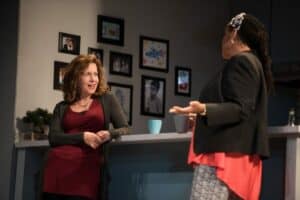Boomers Considering What They Were and Are: 20th CENTURY BLUES at CATF
Posted on BroadwayWorld.com July 15, 2016
“Look at us!” is the last line, but also pretty much the substance, of Susan Miller‘s play 20th Century Blues, now being presented as part of this year’s Contemporary American Theater Festival in Shepherdstown, West Virginia. We are invited to look at four women’s pictures culled from annual photoshoots of the quartet over forty (or is it thirty-nine?) years. The question whether the fortieth and final shoot will have happened at the moment the invitation is issued to the audience is almost the only suspense in this play. Apart from that, the play might be described as a nearly formless review of themes associated with aging New York Baby Boomer women.
The four women – photographer Danny (Betsy Aidem), real estate agent Sil (Alexandra Neil), veterinarian Gabby (Kathryn Grody), and journalist Mac, the only black and the only lesbian member of the quartet (Franchelle Stewart Dorn) – are a random sampling of this demographic, thrown together initially by the shared experience of having been arrested at the same forgotten demonstration. But separately and together, they have been through everything women of their class went through, including of course the predictable marriages, divorces, adoption, marijuana, senile parents, physical decline, retirement, and all the “Terrible Things,” starting with the John Kennedy assassination. In their fortieth reunion, we review it all.
At least we see the characters joke about it all, and/or ponder it lightly. Here is Sil’s recollection of that first “Terrible Thing”: “My husband was studying for the Bar Exam with some of his buddies. I walked in to give them more caffeine, and they were just standing in the middle of the room. All these young men in their madras shorts and loafers crying in front of the TV.” Or Mac’s explanation of why she’s hesitant to marry her partner, even though same-sex marriage is now available: ” But, what if I turned out to be a bad example? What if I make a terrible spouse? Then it’s not just my relationship that’s failed, it’ll be a strike against the cause…. When you’re an African American and a woman and gay, it can be a little tricky as to which cause you’re most afraid of not living up to at any given time. (beat) And — I don’t want to get divorced.”
You can see how this is slightly piquant but not deep. The detail of the madras shorts, evocative, though of what is not clear. And the meditation on letting down the multiple causes, gently comic, but again not terrible revelatory. It’s very pleasant, and you chuckle from time to time, particularly if, like me, you’re part of the age cohort under consideration. But it frequently sounds like sitcom writing, a legitimate thing but not precisely the legitimate theater.
My first reaction upon seeing the play was that it was the best-written of the five on offer at this year’s Festival. But as it dissolves in the mind, it really dissolves, leaving very little behind. Should it be judged wanting on that score? That’s a really hard question.
Perhaps the answer turns on how much Boomer self-indulgence we are willing to entertain. The characters remember, for instance, when the fashion of the times encouraged them to hold mirrors up to their vaginas. Danny comments “I never really understood what I was looking for.” Precisely: a body part of interest to physicians and lovers and pornography consumers reveals little as an object of introspection. And much of what we Boomers do revolves around the unproven proposition that we are worthy objects of scrutiny, whether exercised by ourselves or by others.
If we really believe we rate that time before the mirror, then the fact that little of great note may be revealed there should not be a deterrent to holding the play in esteem. I suspect that Millennials are thoroughly tired of their parents’ introspection, and this play might not be for them.
Or not yet. As I continued to consider the play, I realized that the characters are presented more as processes than objects. The point is not merely what they and we have been through, nor merely that plus what we’ve all learned by going through it in a particular time and place. Perhaps most important, 20th Century Blues (notwithstanding its title) addresses, from the inside and the outside, the universal experience of aging, an experience common to all times and places. Here is Danny, talking about coming to terms with the fact that that experience happens to everyone who lives long enough:
“I used to think old people came into the world that way. There were babies. Children. Adults. And old people. It didn’t sink in for a long time that one person, including me, would actually change, inexorably, from one to the other. That one person could embody all those opposing forms.” And hence, to be scornful of age, as if it were some kind of willed failure, is as stupid as it is cruel: “But, doesn’t our acquiescence to this collective shame about being a certain age have a diminishing effect on our ideas and culture? Are we willing to let that happen? Are we really willing to sacrifice a generation each time it grows old?”
It is probably because of this “seven ages of man” (or woman) theme that playwright Miller has incorporated two characters from outside the focus demographic: Danny’s aging and somewhat demented mother Bess (Mary Suib) and her adoptive son Simon (Jason Babinsky). Across the generations, the three form a unified and loving family, the continuum of age cohorts in action. I’m not sure that the mother and the son have enough work to do in this show to justify their presence, but that seems to be what Miller is driving at by including them.
In any event, there is sufficient substance to the cumulative discussions of aging throughout the show to make it more than a pleasant visit to sitcom-land. The show is about more than just us navel-gazing Boomers.
As I constantly have occasion to comment of shows at this venue, the acting, the direction (in this instance by Ed Herendeen), and the production (particularly David M. Barber‘s ingenious set), are all to the Contemporary American Theater Festival’s typical high standard. You could do far worse than include this play in your Festival visit.
Copyright (c) Jack L. B. Gohn, except for production photo (photo credit Seth Freeman)


 I lived in London and Vienna before coming to the United States, and grew up mainly in Ann Arbor. I was writing plays and stories as early as grade school. My undergraduate years at the University of Pennsylvania, where I first reviewed theater, for the college paper, were succeeded by graduate study at the Johns Hopkins University, where I earned a doctorate in English Literature.
I lived in London and Vienna before coming to the United States, and grew up mainly in Ann Arbor. I was writing plays and stories as early as grade school. My undergraduate years at the University of Pennsylvania, where I first reviewed theater, for the college paper, were succeeded by graduate study at the Johns Hopkins University, where I earned a doctorate in English Literature.